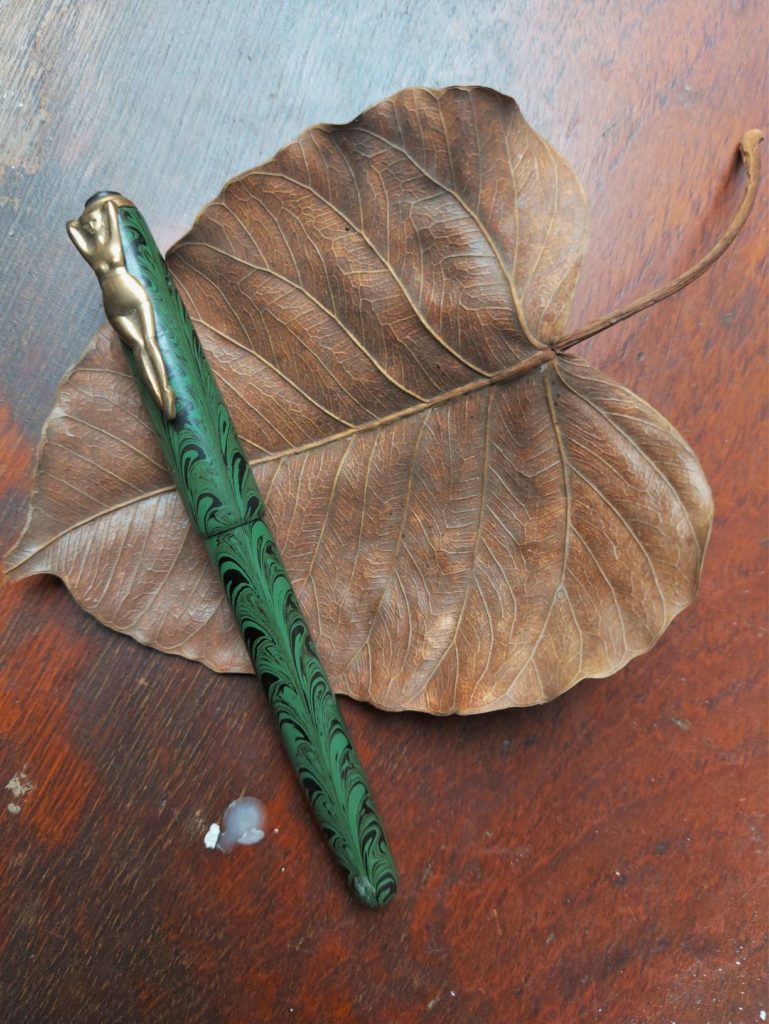Vintage Indian ebonite fountain pens, anyone?
“What is your greatest regret as a fountain pen collector?” asked the young lady who had come to take my interview.
“Regret”? I heard myself mumbling far away, for her question had hit me straight in the solar plexus. “Fountain pen collecting, on the contrary, is about unbridled joy. It is about the pleasure of reclaiming the past and restoring it for future generations” I was saying through the haze.
But her question had already touched a raw nerve. Exposed a wound that simply refuses to heal. A running sore that no number of balms sourced from the snow bedecked Montblanc peaks, flown in by Pelikans or administered by Sailors can heal. For, regret I have, that too, a terrible one. That my fellow fountain pen lovers do not accord the love and respect that is due to the India made fountain pens of the vintage stock. Yes, I am talking of the Vintage Indian ebonite.
Yes, we do hear hollow exhortations like “be Indian, buy Indian” from time to time. Yes, there are the odd collectors who flaunt the “Make in India” mnemonic with half-hearted bravado, which I feel, is more fuelled by underlying political (read jingoistic) compulsions than out of a genuine love for fountain pens, leave alone the Vintage Indian ebonite. And off-course, there are the regular “sellers” who religiously seize every sacred occasion – from the Republic to the Independence Day (and Holi and Diwali in between) – to push garish contraptions with a splattering of the tricolour to peddle their so-called “hand-turned” fountain pens that are cobbled together from imported components that make a mockery of everything. Especially the passion of innumerable fountain pen collectors, but that is not the point.
The point is that the fault is in us. Why are we running after the tinsel when the nuggets of gold and silver are strewn all around us? Why, when Vintage Indian ebonite pens can be picked up, that too at a pittance, from any city, town or village shop? All it takes is a little perseverance and anyone can stumble across a hoard that is lying unsung and uncared for in some forgotten shelf in what used to be a stationery shop. I am saying “used to be”, because most have gone through a transformation – from stand-alone pen turners to stationery outlets to STD/ISD booths to Xerox centres to what not and will need some searching, unless one is a local or knows one who can help.
The middle and lower ends of the Indian market was once the level playing field of innumerable pen turners. In those days of import restriction, the sheer size of the market and the lack of enough players in the organised sector had given rise to the near ubiquitous pen turner who used to cater to the local demand. The flood of Chinese pens (read Wing Sung, White Feather, Hero of the 1980’s) or the menace of plastic moulded ones were yet to happen and most of the stand-alone pen turners were a happy lot, easily selling whatever they could produce. Most did not bother with the branding and some who did, used every conceivable name to create their own identities. As a matter of fact, if one is a little vigilant, one can still come across vintage Indian ebonite pens with names as diverse as Astronaut and Anita.
But the point that needs to be underscored here is that some of these vintage Indian ebonite pens, if not all, were of excellent built quality. Made mostly of locally sourced ebonite, these hand-turned pens were basic eye-dropper fillers that were fitted with generic, tipped nibs. Mottled or plain, the ebonite used to range from brown through green to black with other colours being the exception rather than the rule. Those were times when even electricity powered lathe machines were a luxury and most of the pens were turned manually, yet, they stand out for two things – their sturdiness and craftsmanship. Not only are such vintage Indian ebonite pens excellent in terms of durability and robustness; but are also extremely well crafted.
And there were compelling reasons for these pens being what they were. Those were the days of rationing and money was scarce. A pen, which was a bare necessity, was something the one bought for daily, regular use. Students wrote pages at an end. For elders, it was the primary instrument aiding communication. Naturally, every paisa counted and one looked for value for money in everything one spent on. Naturally, the pen had to be a performer. Besides, the people who made these pens, depended on them for their livelihood, having learnt the art of turning often after many agonising years spent as apprentices. There were neither schools dishing out certificates on pen turning, nor were there You Tube tutorials to cut through the maze. The cost of failure – to the user as well as the maker – used to be a steep one, which ensured that matters like quality control took care of itself, for something much greater was at stake: the very survival of the entity. Remember, there were no collectors then, people who would buy for the sake of hoarding and then, for their own vested interests post emogies to applaud even where no merits are due.
And it is this vintage Indian ebonite pen that I collect. The unnamed, unbranded, unsung fallen soldier who gave up his life defending the frontiers of the Nation’s knowledge. And my regret? Simple – that I have not been able to do enough to bring the sacrifice of these vintage Indian ebonite fountain pens into the limelight, to have enough passionate fountain pen lover jump in to resurrect their memory, so that they the vintage Indian ebonite fountain pens can be put on the pedestal and worshipped with the reverence that they deserve.

